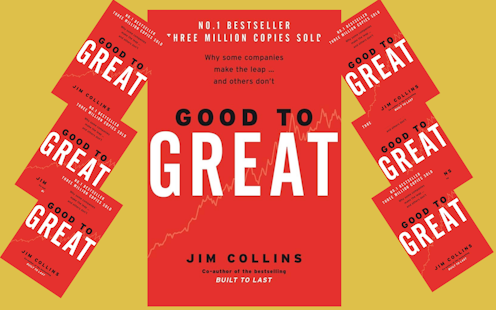
As important as what to read is what not to read. So instead of recommending a book on leadership or management (these categories get very confused), I want to suggest that nobody read the ostensible classic, Jim Collins’s Good To Great, first published in 2001 and a steady bestseller ever since.
What’s wrong with this book? Let me count the ways. For me, its first flaw lies in its language. Collins is forever talking about his “lab”, with the implication that management is a science that can be studied with every bit as much rigour as, say, chemistry or physics.
But that is absurd. You can’t do controlled experiments in business because each company is different, markets keep changing, customers and trends are fickle and uncertainty is rife. What works for one company doesn’t necessarily work for another.
In science, a good theory is one that has high predictive capability; if I let go of a cup I’m holding, the theory of gravity predicts it will fall. We have no equivalent theories in business. Management is not a science.
Collins didn’t work in a lab, putting companies under microscopes. He assembled a bunch of researchers who tried to measure company performance to define which ones were great. The research team didn’t visit the businesses or interview its employees but worked from published, not firsthand, materials.

Welcome to our series on key titles that have helped shape business and the economy – as suggested by Conversation writers. We have avoided the Marxes and Smiths, since you’ll know plenty about them already. The series covers everything from demographics to cutting-edge tech, so stand by for some essential reading.
And the definition of greatness that they settled on is startlingly obscure: great companies are those in the Fortune 500 list of the largest US firms that, between 1964 and 1999, achieved returns exactly 6.9 times greater than the stock market over 15 years. Out of 1,435 companies, just 11 meet these criteria.
No private companies were included in this sample set, nor any family or employee-owned businesses. At a time when globalisation was in full swing, all the companies studied were American. And the stock price is the ultimate arbiter; externalities don’t exist in Collins’ world. Perhaps unsurprisingly, many fell from greatness after the book came out.
Continuing the pseudo-scientific theme, Collins writes about “flywheels” that throw off huge success, as though each company is a machine needing magic oil. He favours “big hairy audacious goals” (BHAGs) to build flywheel momentum, a concept that has lured more than a few CEOs into crazy unstrategic flights of fancy.
Yet, Collins purports to offer “timeless universal answers” as immutable as the laws of nature. So how are these exceptional results achieved? CEOs must be ambitious and aim high. That insight surely doesn’t count as a discovery. They hire the right people and confront brutal facts. Unarguable, but impossible to do every time. They stay focused on the metrics that matter. Easy to say, hard, in fact, to distinguish between the metrics that count and those that don’t. They also deploy technology carefully and their leaders stay humble. So far, so banal.
One of Collins’ prosaic phrases made most famous by the book concerns getting the right people “on the bus” and the wrong ones “off the bus”. Well, yes, but how do you know in advance which are which? That’s the hard part. Great people in one company can be disasters in another. What changed – the people or the bus?
Collins, a Stanford mathematician, presents lucid, intelligent analysis of the numbers but his conclusions scarcely seem to merit the effort that went into the work. The aspiration seems to be to prove beyond doubt that consistency, discipline and focus are the ingredients of a secret sauce, but did anyone ever think that these attributes didn’t matter? Causation and correlation are inferred (as they so regularly are in business) but few scientists I know who’ve read the book come away impressed.
The startling black hole at the centre of the book is context. The biggest single challenge for CEOs is knowing how to respond to uncertainty and change. Churchill was a great war leader but arguably dire in peacetime.
Attribution errors are rife among leadership studies because it’s so hard to prove where decisive differences lie. Can you really assign the success of a company entirely to its CEO? Did a business thrive because of the boss, because its competitors were stupid, because it rode a boom, or was it just lucky?
Jim Collins on teamwork and those big hairy audacious goals (BHAGs)
In startups, is it because the founder had a great idea or a tremendous network? Maybe it was two people in the marketing team who swung it. Or it could have been all the above.
Good to Great exemplifies the airport business book: flattering to its tired but aspirational readers and reassuring in its formulaic simplicity. It’s not as crass as many, but in its own aspiration to position management as a science, it has done untold harm.
The world is full of CEOs who now imagine themselves as engineers building the flawless machine that will never break, that will grow ever more efficient and never tire. In their fruitless pursuit, they add more and more rules, goals, targets, key performance indicators, jargon and bureaucracy and then wonder why their people aren’t more “engaged” — a typically mechanical metaphor.
In doing all that they miss what can be the true glory of management: that it is alive, creative, frequently unpredictable and different from one day to the next. As uncertain, in fact, as human life itself.
References^ Good To Great (www.penguin.co.uk)^ published, not firsthand (www.jimcollins.com)^ series (theconversation.com)^ 1,435 companies, just 11 (readingraphics.com)^ “big hairy audacious goals” (www.jimcollins.com)^ Stanford mathematician (thinkers50.com)Read more








